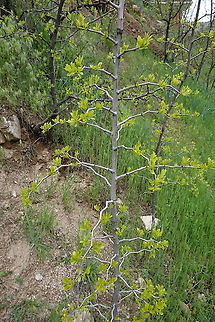
Appearance
It is a small deciduous tree or shrub reaching a height of 5–12 metres , usually with thorny branches. The leaves are shiny-green, ovate-acute, 2–7 centimetres long and 1–3 centimetres wide, with three conspicuous veins at the base, and a finely toothed margin. The flowers are small, 5 mm wide, with five inconspicuous yellowish-green petals. The fruit is an edible oval drupe 1.5–3 centimetres deep; when immature it is smooth-green, with the consistency and taste of an apple with lower acidity, maturing brown to purplish-black, and eventually wrinkled, looking like a small date. There is a single hard kernel, similar to an olive pit, containing two seeds.Distribution
Its precise natural distribution is uncertain due to extensive cultivation, but is thought to be in southern Asia, between Lebanon, northern India, and southern and central China, and possibly also southeastern Europe though more likely introduced there.This plant has been introduced in Madagascar and grows as an invasive species in the western part of the island. This plant is known as the "hinap" or "finab" in the eastern part of Bulgaria where it grows wild but is also a garden shrub, kept for its fruit. The fruit is picked in the autumn. The trees grow wild in the eastern Caribbean, and are reported to exist in Jamaica, The Bahamas, and Trinidad as well. In Barbados and Guyana the fruit is called "dongz" or "donks" In Antigua and Barbuda, the fruit is called "dumps" or "dums"; and in The Bahamas, "juju". It is also known as "pomme surette" on the French islands of the Caribbean. This fruit, more precisely known as "Indian jujube" elsewhere, is different from the "jujube" fruit that is cultivated in various parts of southern California. Altun Ha, an ancient Mayan city in Belize, located in the Belize District about 50 kilometres north of Belize City and the surrounding woods, also boasts some jujube tree and shrub varieties where it is referred to as plums for lack of a better word among locals.
Uses
Jujube was domesticated in south Asia by 9000 BC. Over 400 cultivars have been selected.The tree tolerates a wide range of temperatures and rainfall, though it requires hot summers and sufficient water for acceptable fruiting. Unlike most of the other species in the genus, it tolerates fairly cold winters, surviving temperatures down to about −15 °C and the tree is for instance commonly cultivated in Beijing. This enables the jujube to grow in mountain or desert habitats, provided there is access to underground water throughout the summer. The jujube, ''Z. jujuba'' grows in cooler regions of Asia. Five or more other species of ''Ziziphus'' are widely distributed in milder climates to hot deserts of Asia and Africa.
In Madagascar, jujube trees grow extensively in the western half of the island, from the north all the way to the south. It is widely eaten by free-ranging zebus, and its seeds grow easily in zebu feces. It is an invasive species there, threatening mostly protected areas.In Japan, the ''natsume'' has given its name to a style of tea caddy used in the Japanese tea ceremony, due to the similar shape. Its hard, oily wood was, along with pear, used for woodcuts to print the world's first books, starting in the 8th century and continuing through the 19th in China and neighboring countries. As many as 2000 copies could be produced from one jujube woodcut.
In China, the leaves are sometimes picked for teas, such as by families in Laoshan Village, Shandong Province, China, where it counts as a variety of herbal tea.
The timber is sometimes used for small items, such as tuning pegs for instruments. Select grade Jujube timber is often used in traditional Asian instruments for fingerboard, pegs, rests & soundposts, ribs & necks etc. It has a medium to hard density similar to luthier grade European maple and has excellent tonal qualities. You will find jujube Wood in local folk instruments from Ceylon/India thru to China/Korea; it is also commonly used in China in violin & cello making for overseas export, though usually stained black to imitate the look of ebony. Luthier grade jujube wood planes and carves beautifully.
Cultural
In Arabic-speaking regions the jujube and alternatively the species ''Z. lotus'' are closely related to the lote-trees which are mentioned in the Quran, while in Palestine it is rather the species ''Z. spina-christi'' that is called ''sidr''.References:
Some text fragments are auto parsed from Wikipedia.